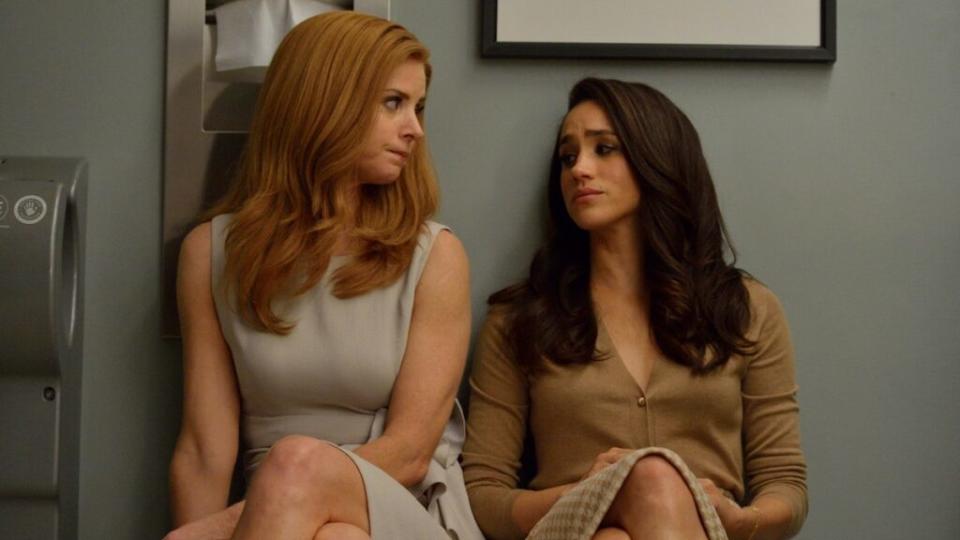‘Suits’ Is a Streaming Hit – and a Case Study for Why Residuals Are a Sticking Point in the Strikes
- Oops!Something went wrong.Please try again later.
- Oops!Something went wrong.Please try again later.
With Hollywood’s historic double strike shining a light on who benefits when a show becomes a streaming hit, the surprise resurgence of “Suits” presents a unique case study for a residuals model that actors and writers say is broken.
After its run on USA Network from 2011 to 2019, the legal drama set a new weekly record as the most-viewed acquired streaming title during the last week of June. The drama series starring Patrick J. Adams and Gabriel Macht logged 3 billion minutes from June 26 to July 2, then shattered its own record, gathering 3.7 billion viewing minutes in a single week. Overall, it garnered over 12.8 billion minutes of viewing across Netflix and Peacock from June 19 to July 16.
How much did the streamers make off that runaway success? It’s hard to say. When a syndicated show runs on broadcast or cable, it runs with ads, providing a clear revenue stream linked to viewership. Though Netflix now offers a cheaper version of the service with ads, as does Peacock, most streaming subscribers pay for a subscription in part so they don’t have to watch ads. That complicates the business model that underpins residuals.
And that’s part of the reason why, despite its staggering success, primarily boosted by its return to Netflix as a licensed title, most “Suits” actors and contributors won’t receive a sizable check from the streaming service — including “Suits” writer Ethan Drogin, who shared that he received just $259.71 in streaming residuals last quarter in an LA Times op-ed.
Ray Proscia, who played recurring character Dr. Lipschitz on “Suits,” told TheWrap he’s also not expecting to receive a sizable check in the next quarter despite the show’s massive viewership. He’s one of the thousands of striking actors who believes streaming residuals should be success-based — even though it’s far from clear what constitutes “success” when viewing is subscription-based.
“You’re talking about any business, if a product that is being supplied by a company is used over and over and over again, I believe the person who invented that product should get a piece of that,” Proscia told TheWrap. “In the case of ‘Suits,’ I invented Dr. Lipschitz… It’s not as if another actor is taking the role and then continuing on… It is my likeness. It was my performance. It is my creativity.”
Noting that he had a smaller role in the legal drama, Proscia listed main cast members Gabriel Macht, Sarah Rafferty and Rick Hoffman as the stars that “are the show.” “The fact that they’ve created these characters that have made the show so popular, they should be rewarded in kind,” Proscia said.
“People wanting residuals isn’t new,” SAG-AFTRA member Jaimie Paulson told TheWrap on the picket lines in late July. “Residuals have always been a part of this industry. It’s the streamers that are changing it. It’s not that we want more things — we want what it’s always been in this new world.”
Despite the tension between what actors want and how streaming works today, the world may be coming around to a system where residuals make sense again. Ad-supported tiers and free, ad-supported television are some of the fastest-growing parts of streaming. As those services grow in popularity, the actors’ and writers’ demands for residual payments could fit better into the industry’s ever-shifting business model.

How do streaming residuals work?
Since “Suits” is not a streaming original, and is instead a library show licensed to another distribution outlet in a secondary window, the residuals are a percentage of gross paid to license the show, an individual close to Universal Studio Group, whose division UCP produced “Suits,” told TheWrap.
In layman’s terms, any show licensed from a studio to a streaming service — which includes the likes of network and cable classics like “Seinfeld,” “Gilmore Girls” and “Grey’s Anatomy” — is paid for by the streamer to the studio upfront through a deal negotiated between both parties. From there, the studio pays the guilds per collective bargaining agreements with the WGA, DGA and SAG, and the guilds then distribute residual payments to members and nonmembers. (Because the Producers Guild is not a union and cannot negotiate with the studios, individual producers do not receive residuals, though they may benefit from other forms of profit participation.)
Unless those contractual payments are designed to vary based on viewership — and they typically aren’t — there are no additional funds available to finance variable residuals after the upfront payment is made.
Streamers do pay residuals for their streaming originals, which in includes shows like “Wednesday,” “Bridgerton” and “The Witcher,” Peacock’s “Mrs. Davis” and Hulu’s “Only Murders in the Building,” among others. Those writing, acting or directing on a streaming show get separate residuals for domestic and foreign and foreign streaming.
Residuals collected by the WGA hit an all-time high of $493.6 million in 2021, with those from streaming accounting for almost half (45.2%) of the total collected, per the WGA 2022 annual financial report. Most of those came from Netflix, according to an individual familiar with the financial details. While the WGA did not publish a 2023 report, a copy of that report obtained by Deadline did not share comparable residual data.
‘It’s a different world than it was’
While actors, writers and other contributors on licensed shows like “Suits” receive a set percentage every time their show runs on cable or broadcast, the streaming model has completely shaken up how contracts are sorted and how residuals are paid.
“The whole business has fundamentally changed and for that reason how people are paid and compensated has changed,” Paul Hardart, director of NYU’s Entertainment, Media and Technology program, told TheWrap. “Whether it’s SAG or WGA or the AMPTP, I think everybody would agree [that] things changed. It’s a different world than it was… and at the core of it, interests are not really aligned anymore.”
Streamers began introducing front-end deals to the table when Netflix rose to prominence, crafting a deal in which streamers license a show from a studio for a higher fee, while not providing additional payments down the line.
“The difference is (on broadcast or cable) you’re getting a piece of every time it runs and how it does, and so if there’s money coming in, there’s a calculation of how it gets paid out,” Hardart said. “Whereas on streaming, Netflix was doing this sort of cost-plus model where they buy out the show.”

Though Hardart admits this model is beneficial in the short term by giving the studios a higher payment upfront, he notes that “there’s no downstream revenue like there used to be and there’s no longer a connection to performance — that’s where the interests aren’t really aligned.”
Whereas broadcast and cable TV continue to be governed by ratings as advertisers set rates for viewership among key demographics, streamers like Netflix have “a different way of measuring success,” according to Hardart, who points to the average revenue per user measurement. Streamers also watch for new sign-ups and churn.
It’s quite possible that a show, however popular, might not have much effect on these numbers. While “Suits” actors, writers and other crew members might be happy that more people are watching their show on streaming — or unhappy because they’re not seeing a financial benefit — that viewership does not necessarily translate to financial success for the streamers.
“They don’t entirely care whether you watch a whole lot of ‘Gilmore Girls’ or not, they just want you to keep paying for the service,” Hardart said. “That’s the main driver of their business. So whether or not the show does well, it’s kind of inconsequential — they just want you to keep paying.”
Even for streaming originals like Prime Video’s “The Summer I Turned Pretty” or Netflix’s “Stranger Things,” residuals are based not on performance, but are instead “determined by the length of the program (Residual Base), the size of the service when the program was written (Subscriber Factor), and the exhibition year (Exhibition Year %),” according to WGA guidance.
With performance not linked to residuals for streaming, the streaming model renders ratings somewhat meaningless. Ad-supported streaming viewership, where viewership measures might matter more, is growing quickly, but it’s still small compared to subscription-based viewing.
Since streaming service viewership data is not released publicly unlike broadcast and network TV, streamers like Hulu, Prime Video, Max, Peacock and others don’t have a consistent mechanism to share ratings, and the industry has jealously guarded its data, with limited exceptions.
Every Tuesday, Netflix reveals its top 10 most-watched programs of the week across several categories: English TV, English films, Non-English TV and Non-English films, as well as their top 10 most popular programs across the same categories. There is no public data on how a show has done if it does not make the list (i.e. the streamer doesn’t publicize its failures), and Netflix’s own numbers aren’t independently vetted.

The sticking points
Although the streaming model does not require nor expressly benefit from sharing viewership data for its programs (with the exception of some cherry-picked success stories), striking writers and actors are calling for increased transparency among the streamers as the residuals they once earned from mega-hits — the residuals that kept many actors and writers afloat — has dwindled to minuscule figures.
“Altogether, NBCUniversal paid the six original ‘Suits’ writers less than $3,000 last quarter to stream our 11 Season 1 episodes on two platforms,” Drogin wrote in the LA Times column. “$259.71 for writing a show with an audience so massive? This is why writers and actors are on strike. This is why SAG-AFTRA President Fran Drescher has used terms such as ‘un-American’ to describe this system.”
While switching up front-end deals could mean paying less money to studios at the beginning, most SAG-AFTRA and WGA members on strike are fine with the potential losses if it means their hits would be accurately reflected back to them.
“If you have a huge success, because you’ve managed to sell something that resonated a million times over, we should join you in that,” “Hellboy” star Ron Perlman told TheWrap on a picket line in Los Angeles in late July. “We’re not asking for residuals on flops. We would prefer that you took all of our flops and buried them so deep that even Chernobyl would not unveil them… only in success, we want to be recognized.”
While the DGA secured a deal with the AMPTP for subscriber-based residuals for streamers, using a new formula for foreign SVOD residuals based on international subscribers, SAG-AFTRA and the WGA continue to advocate for success-based streaming residuals.
“The reason they don’t want to show us the residual data that we’re asking for is because either they’re making a s–t ton of money and they don’t want to share it, or they’re making no money at all, and if the shareholders find out they’re absolutely screwed,” WGA captain Jon Sherman told TheWrap on the picket line. “It’s either greed or fraud. Because in an equitable partnership, [we] created this thing for [you], [we] absolutely should have a piece of the residuals.”
For all of TheWrap’s WGA strike coverage, click here.
The post ‘Suits’ Is a Streaming Hit – and a Case Study for Why Residuals Are a Sticking Point in the Strikes appeared first on TheWrap.

